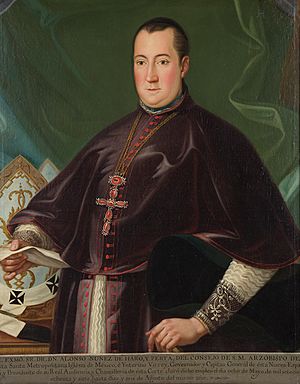Alonso Núñez de Haro y Peralta facts for kids
Quick facts for kids
Alonso Núñez de Haro y Peralta
|
|||||||||||||||||||||||||||||||
|---|---|---|---|---|---|---|---|---|---|---|---|---|---|---|---|---|---|---|---|---|---|---|---|---|---|---|---|---|---|---|---|
 |
|||||||||||||||||||||||||||||||
| 50th Viceroy of New Spain | |||||||||||||||||||||||||||||||
| In office 8 May 1787 – 16 August 1787 |
|||||||||||||||||||||||||||||||
| Monarch | Charles III | ||||||||||||||||||||||||||||||
| Preceded by | Bernardo de Gálvez y Madrid | ||||||||||||||||||||||||||||||
| Succeeded by | Manuel Antonio Flórez | ||||||||||||||||||||||||||||||
|
|||||||||||||||||||||||||||||||
Dr. Alonso Núñez de Haro y Peralta (born October 31, 1729 – died May 26, 1800) was a very important leader in New Spain. He served as the Archbishop of Mexico City for many years. He also briefly held the powerful position of Viceroy of New Spain. This was a top job, like a governor, representing the King of Spain.
Early Life and Learning
Alonso Núñez de Haro was born in a region of Spain called Cuenca. This was around October 31, 1729. He was a very smart and dedicated student.
Where Did He Study?
He started his education at the University of Toledo in Spain. Later, he earned a special degree called a doctorate from the University of Bologna in Italy. After that, he became a professor at the University of Ávila. He was also a canon, which is a type of priest, in the cities of Segovia and Toledo.
His Amazing Language Skills
Alonso was very good at languages. He learned to speak and read Latin, Greek, and Hebrew. He also knew French and Italian. These skills helped him greatly in his later roles. In 1771, he was chosen to become the Archbishop of Mexico.
Archbishop of Mexico
As the Archbishop, Alonso Núñez de Haro was the main religious leader in New Spain. He made many important changes and improvements.
Helping Priests and Students
He changed a former Jesuit school in Tepotzotlán into a special center. This center was for priests to study, retire, or even be held if they broke rules. Priests had special legal rights, so they were judged by Church courts. At this center, he made sure students learned about Mexico's own history. He created classes about Mexican history, the Otomí language, and Church history in the region.
Building and Improving Churches
He also helped with construction projects. He continued work on the Chapel of Pocito in Guadalupe. He also helped with the grand cathedral in Mexico City.
Caring for the Community
Alonso Núñez de Haro cared about people in need. He started a home for abandoned babies, called a foundling home. He also helped establish a convent for Capuchin nuns. He added many books to the archdiocese's library. He even offered scholarships and awards to students who did very well in their studies.
Founding a Major Hospital
In 1770, he turned another former Jesuit building into a large hospital. This was the Hospital San Andrés. It was designed to treat all kinds of illnesses. The hospital was managed by the archdiocese. However, it also received a lot of support from the government.
Hospital San Andrés Details
This hospital eventually became very big. It could hold up to 1,000 patients. It had 39 different rooms or wards. The hospital also had the largest pharmacy in New Spain. It had a lab and a special department for studying bodies after death. The hospital was supported by income from properties and a share of Church taxes. It even had a special right to control the game of pelota (a ball game) to earn money.
Protecting Church Beliefs
He was very serious about Church teachings and correct beliefs. He spoke out against a certain idea called probabilism. This idea was supported by the Jesuits. He also believed in obeying the Spanish King. He asked his followers to pay their taxes to the King. This was to prevent people from cheating the government.
Viceroy of New Spain
Usually, the King of Spain chose non-religious people to be the Viceroy of New Spain. But sometimes, if a Viceroy died or left office suddenly, the Archbishop of Mexico would step in.
A Short Term as Viceroy
The previous Viceroy, Bernardo de Gálvez y Madrid, died in November 1786. So, Alonso Núñez de Haro was chosen to be the temporary Viceroy. He started this role on May 8, 1787. He served for about three months. On August 16, 1787, he handed over the job to the new Viceroy, Manuel Antonio Flórez.
Important Changes During His Time
Even though his time as Viceroy was short, he made some important decisions. He helped set up the "intendencias." These were new ways of organizing the provinces across the colony. They helped the Viceroy manage the different regions better.
Starting a Botanical Garden
He also helped create a botanical garden. This was a special garden where plants from all over New Spain were collected. A naturalist named Martín Sessé y Lacasta was put in charge of it.
Helping Indigenous People
Alonso Núñez de Haro tried to help the Indigenous people. He wanted to end the special taxes they had to pay, called "tribute." However, his orders were not fully carried out. He also suggested making the courts for Indigenous people fairer. He wanted to cut down on costs and complicated rules.
Life After Being Viceroy
After his time as Viceroy, Alonso Núñez de Haro continued to be the Archbishop of Mexico. He held this position until he died in 1800. In 1792, King Charles IV gave him a special award called the Gran Cruz de Carlos III. Even after being Viceroy, he continued to receive the respect and honors given to a Viceroy of New Spain.
Images for kids
See also
 In Spanish: Alonso Núñez de Haro para niños
In Spanish: Alonso Núñez de Haro para niños


